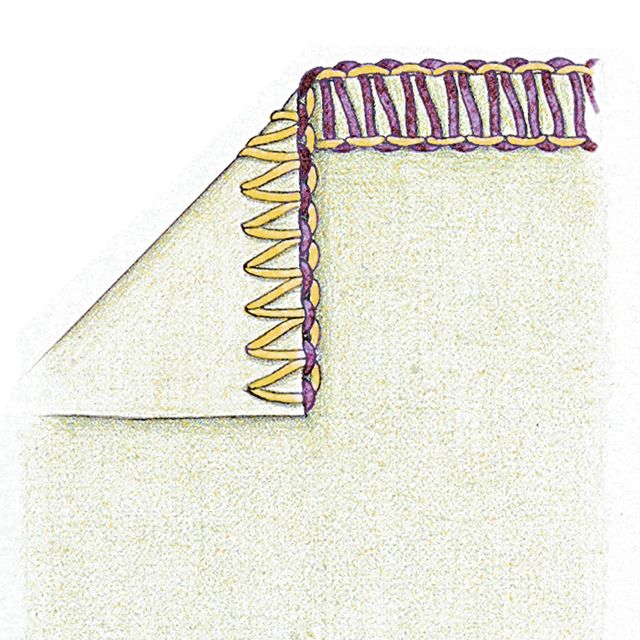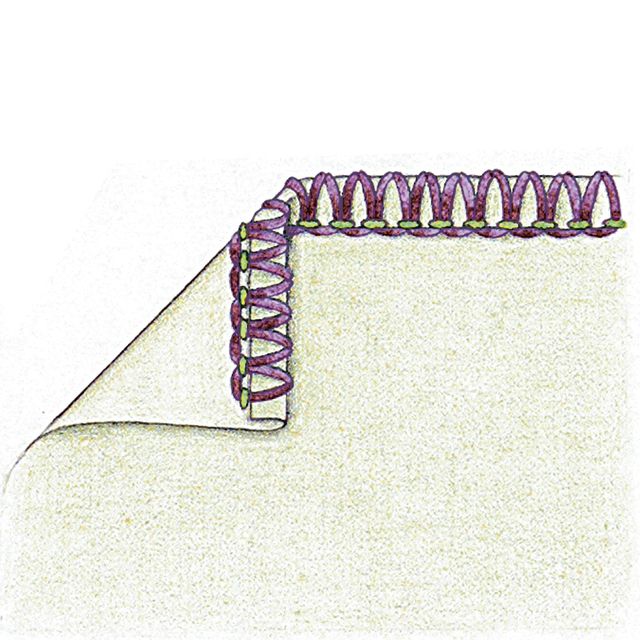The Right Serger Stitch for Your Project
When you do opt for a serged seam or edge-finish, choose the stitch that matches the needs of your garment.
Even the most basic serger can produce several stitches. Here’s a look at the whole family of stitches and the best use for each.
A serger stitch adds stretch and strength to seams, simplifies edge finishes, and even embellishes a garment.
With so many stitches to choose from, it’s hard to know which stitch to use on which fabric or when not to serge at all. Some of these questions can be answered by learning about the standard serger stitches and their attributes.
Be aware that not all sergers can make every stitch, so check the machine’s manual to see what it can do. If you’re shopping for a new serger, make sure the model you choose has the stitches you want.
To serge or not to serge
To decide whether to use your serger instead of a conventional machine, it’s important first to understand the difference in these two types of stitches: On a serger, the looper threads are looped and interlaced—in effect, knitted—with the needle thread(s), and they wrap around the fabric’s edge; on a standard machine, the bobbin thread locks with the needle thread to create a line of stitching on the fabric.
Next, think about your fabric: how you’ll use it and how often you’ll wash it. Is it a knit you’ll wash frequently? A woven destined for sportswear and a one-season life span? Or a sheer, crinkled fabric for a loose-fitting garment? In all these cases, the serger is the way to go for seaming and edge-finishing. But if you’re making a straight wool skirt or a linen blazer, serging the seams yields bulky lines rather than the smoothness of pressed-open seams. And if you plan to line your garment, finishing edges with the serger is a waste of thread because all seams will be enclosed.
Selecting a serger stitch
When you do opt for a serged seam or edge finish, choose the stitch that matches the needs of your garment. Keep in mind that a serger stitch with fewer threads can have a lot of strength and stretch. Stitches with more threads tend to be bulkier rather than stronger, though there are exceptions, like the superstretch, three-thread wrapped stitch. And stitches incorporating the chainstitch make a stable, nonstretchy seam.
As a rule, use a narrow stitch with fewer threads for lightweight fabrics, wrapped stitches for maximum stretch on knit seams, overlock stitches for standard seams on knits and wovens, and wider overlock stitches with the most threads for ravelly or bulky fabrics. These stitch types are defined below. Flatlock stitches are wonderful for sportswear that needs to be comfy on the inside, and rolled-hem stitches finish delicate sheers beautifully. Thread tensions may need adjustment depending on the particular fabric and for flatlock and wrapped stitches.
To reduce the bulkiness of serged seams that use a lot of thread, use a long stitch length. Be sure to experiment with stitch length on a sample first. If the stitches are too far apart, the resulting seam may not be strong enough, especially on loosely woven fabrics.
On many machines, for two- and three-thread stitches, you can choose between using the left needle for a wide stitch, the right for a narrow stitch, or using the machine’s rolled-hem function to produce a very narrow stitch (see the photo at left). And don’t forget embellishment: Take advantage of the fact that a serger’s loopers don’t pierce the fabric, meaning you can use heavier, decorative thread in one or both loopers to turn a seam or edge-finish into a design element.
The names of the stitches may be confusing at first, and may vary slightly from manual to manual, but all relate to how the stitches are formed. Two-thread stitches are generally called overedge, or overcast, because the threads don’t interlace at the needle. Three-, four-, and five- thread stitches are referred to as overlocked because the needle thread interlaces with the loopers to form a knot at the needle line. And when the looper thread completely encircles the edge of the fabric on some two- and three-thread stitches, the stitches are called wrapped.
Once you become familiar with the wide variety of stitches offered on sergers, you’ll develop a sense of when to use a stitch. Then use them often so your garments look better and last longer. Here are just a few of your options.
Two-thread stitches
Two-thread overedge
Configuration: Needle thread lies across bottom of fabric and looper thread across top; threads intersect at edge.*
Qualities: Lightweight and stretchy.
Best uses: Superb as edge-finish on delicate fabrics. Narrow-width stitch is good alternative to rolled hem.

Two-thread flatlock
Configuration: Same as over-edge but with fabric layers pulled apart to lie flat. Sewing with wrong sides together places lower-looper thread on outside; sewing with right sides together places needle thread on outside.*
Qualities: Stretchy and strong; reversible stitch that looks good on both sides.
Best uses: Seams on sportswear, outerwear, and sheers (in narrowest width); decorative stitch on wovens and for piecing.

Two-thread wrapped
Configuration: Lower-looper thread wraps around fabric’s edge from front to back, locking with needle thread at needle line.*
Qualities: Strong and stretchy. Best uses: Seams on lightweight fabric, or edge-finish (nice with decorative thread in looper).
Best uses: Seams on sportswear, outerwear, and sheers (in narrowest width); decorative stitch on wovens and for piecing.

Two-thread rolled hem
Configuration: Same as two-thread wrapped in narrowest width.
Qualities: Narrow and strong.
Best uses: Edge-finish on lightweight and sheer fabrics. Not generally used as seam.

Two-thread chainstitch
Configuration: Special chain needle interacts with separate forward chain looper. Needle thread appears as straight stitch on top of fabric, looper thread lies in coil between knots of needle thread on bottom.*
Qualities: Not stretchy, unravels easily.
Best uses: Basting, decorative topstitching, and chain production (chain must be started in fabric but can continue without fabric).

Three-thread stitches
Three-thread overlock
Configuration: Looper threads interlace at edge of fabric like two-thread overedge and lock with needle thread at needle line.*
Qualities: Stretchy, not as strong as two-thread overedge.
Best uses: Seams on knits and wovens. Use inside needle position for lightweight fabrics, outside needle position for firmer fabrics. Suitable seam or edge finish for sheers in narrow width. With woolly nylon in loopers, narrow stitch can seam very stretchy knits. Makes nice edge in any width with deocrative thread in one or both loopers.

Three-thread rolled hem
Configuration: Loosened upper-looper thread completely wraps fabric’s edge to join tightened lower looper and needle thread at needle line.
Qualities: Strong, but bulkier than two-thread rolled hem.
Best uses: Decorative edge-finishing on medium- to lightweight fabrics. Can be used to seam sheer fabric.

Three-thread wrapped
Configuration: Two-needle threads lock with a single looper thread that’s wrapped around fabric’s edge.
Qualities: Very stretchy, durable.
Best uses: Great for seams on stretch fabrics that must endure stress, such as exercise- and swimwear.

Three-thread flatlock
Configuration: Tension adjusted so fabric can be pulled apart after seaming. Needle thread loosened considerably with lower-looper tension tightened; lower-looper thread holds the seam together.*
Qualities: Reversible stitch that looks good on both sides. Not as strong or stretchy as two-thread flatlock (woolly nylon in lower looper increases strength of stitch).
Best uses: Seams on exercise wear or wherever flat seam is wanted. Good for lingerie and fake fur.

Cover hem stitch
Configuration: Two needle threads interact with a single lower-looper thread acting as a chain looper. Appears as two rows of parallel stitching on right side and looper on wrong side. Made like two-thread chainstitch, but uses three threads instead of two.
Qualities: Moderately stretchy and strong.
Best uses: Hem-finishing, topstitching, and construction.

Four-thread stitches
Four-thread overlock
Configuration: Sometimes called 3/4 stitch. Looper threads meet at fabric’s edge, locking with two needle threads at stitching line.
Qualities: Bulkier, more stable than three-thread overlock. Extra needle thread secures looper threads in place.
Best uses: Seams where durability is important or fabric ravels easily. Good for both knits and wovens.

Four-thread safety stitch
Configuration: Combination of two-thread overedge and two-thread chainstitch.*
Qualities: Stable, durable.
Best uses: Seaming on woven fabrics. Especially functional on lightweight fabrics.
Five-thread stitch
Configuration: Combination of two-thread chainstitch and three-thread overlock.*
Qualities: Widest seam possible on serger. Stable and durable.
Best uses: Seams on medium- to heavyweight or ravelly fabrics, both knit or woven.

Written by Millie Schwandt and excerpted from Threads #80, p.41.
More on sergers
• 6 Serger Secrets
• 4 Serging Techniques
• Video: How to Serge Seam Allowances



























































Thank you for the clarity of the instructions and the diagrams. I love diagrams that are color coded. Makes things so easy to understand.
Good basic information on when to use each stitch and clear graphics. Thanks.
Congratulations ! Great work
Unless and incomplete article.
Good! thanks
Please add a pdf or print button so that when can keep these important tips in an easy place to reference. When you try to print form this page items end up over the body of the text.
If you change the format from "original" to "simplified," it will fix the problem.